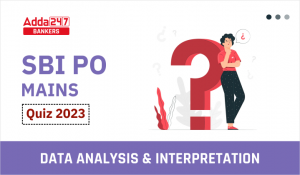(a) the customers
(b) the banks
(c) Reserve Bank of India
(d) Both (a) and (b)
(e) None of the given options is true
S1. Ans.(d)
Sol. Real-time gross settlement benefits to both Banks and customers.
Q2. Which of the following banks has opened the country’s first, ‘Cash Factory’ in Lucknow which has issued currency notes to all its branches and ATM in that area?
(a) Bank of India
(b) Bank of Baroda
(c) State Bank of India
(d) Union Bank of India
(e) None of the given options is true
S2. Ans.(c)
Sol. To ensure better management of currency notes, the country’s first currency administrative branch of the State Bank of India has come up here in Lucknow. Called “Cash Factory”, it will house the currency chest of the Reserve Bank of India. The licence for the cash factory has been issued by the RBI.
Q3. As we all know, more and more countries/organisations are now going for non-cash transactions and accordingly banks have launched many new products in the market for the same. Which of the following products is a non-cash transaction product?
(a) Only ATM Card
(b) Only Credit Card
(c) Only Smart Card
(d) Only Debit Card
(e) All are non-cash transaction products
S3. Ans.(e)
Sol. All are non-cash transaction products.
Q4. As we have noticed, banks these days are giving more emphasis on ‘Branchless Banking’. What does this really mean?
I. Banks will not have many branches as used to be in the good old days. Instead, the number of branches will be restricted and will conduct only a specified” core business.
II. Banks will launch/operate many delivery channels like ATMs, Mobile Banking/Internet Banking etc, so that people are not required to visit a branch for their usual banking needs.
III. This means banks will issue only debit or credit cards for all types of day-to-day financial transactions. Cheques/cash payments will not be allowed.
Select the correct answer using the codes given below.
(a) Only I
(b) Only II
(c) I and II
(d) II and III
(e) All of the above
S4. Ans.(e)
Sol. All of the above.
Q5. The financial assistance of loans of Rs. 10000 by a bank to very a small borrower will be called-?
(a) Business finance
(b) Government finance
(c) Micro finance
(d) Small finance
(e) KYC finance
S5. Ans.(c)
Sol. The financial assistance of loans of Rs. 10000 by a bank to very a small borrower will be called Microfinance.
Q6. One of the major emphasis of Basel II is that banks should have-
(a) adequate Capital Adequacy Ratio
(b) only few branches in urban centres
(c) more and more branches in rural areas
(d) core banking mode of operation
(e) All of the above
S6. Ans.(a)
Sol. adequate Capital Adequacy Ratio is One of the major emphasis of Basel II.
Q7. ________________ is similar to a credit card, but unlike a credit card, the money comes directly from the user’s bank account when performing a transaction.
(a) Debit Card
(b) Smart Card
(c) Money Card
(d) All of the above
(e) None of the given options is true
S7. Ans.(a)
Sol. A debit card is a plastic payment card that can be used instead of cash when making purchases. It is similar to a credit card, but unlike a credit card, the money comes directly from the user’s bank account when performing a transaction.
Q8. As per the news published in major newspaper/journals hence forth the Credit card holders will be able to access their credit card information though automated interactive voice response system over the phone instead of speaking to the staff. This decision of the banks/credit card companies will provide.
I. an additional hurdle to the customers as people feel comfortable in talking to the staff instead of talking to a machine.
II. an additional security to the customers as this does not allow any staff to handle any transaction directly.
III. some comfort to the banks as they will be able to reduce their staff strength.
Select the correct answer using the codes given below.
(a) Only I
(b) Only II
(c) Only III
(d) All of the above
(e) None of the given options is true
S8. Ans.(b)
Sol. an additional security to the customers as this does not allow any staff to handle any transaction directly.
Q9. The YH Malegam Committee, which Submitted its report a few yaers back (in 2010), was set-up to report on further improvement of the functioning of-
(a) Micro Finance Institutions
(b) Stock Exchanges in India
(c) Cooperative Banks
(d) Regional Rural Banks
(e) Foreign Banks having offices in India
S9. Ans.(a)
Sol. The Board of Directors of the Reserve Bank of India, at its meeting held on October 15, 2010 formed a Sub-Committee of the Board to study issues and concerns in the microfinance sector in so far as they related to the entities regulated by the Bank. Y.H. Malegam was the Chairman of this Committee.
Q10. Basel-II norms are associated with which of the following aspects of the banking industry?
(a) Risk management
(b) Manpower planning
(c) Retirement benefits for the employees
(d) Corporate governance
(e) None of the given options is true
S10. Ans.(a)
Sol. Basel-II norms are associated with Risk management aspects of the banking industry.
Q11. Which of the following is known as Plastic Money?
I. Demand Draft
II. Credit Card
III. Debit Card
Select the correct answer using the codes given below
(a) Only I
(b) Only II
(c) Only III
(d) Both II and III
(e) All of the above
S11. Ans.(d)
Sol. Credit Card and Debit card is known as Plastic Money.
Q12. Many times we read a term CBS used in banking operations. What is the full form of the letter C in the term ‘CBS’?
(a) Complete
(b) Credit
(c) Continuous
(d) Core
(e) Common
S12. Ans.(d)
Sol. CBS stands for Core Banking Solution.
Q13. Which of the following sectors makes maximum contribution to India’s Gross Value?
(a) Services
(b) Agriculture
(c) Industry
(d) Both (b) and (c)
(e) All of the above
S13. Ans.(a)
Sol. The services sector is the key driver of India’s economic growth. The sector is estimated to contribute around 54.0 per cent of India’s Gross Value Added in 2017-18 and employed 28.6 per cent of the total population. India’s net services exports during reached US$ 57.60 billion April-December 2017.
Q14. A centralized database with online connectivity to branches, Internet as well as ATM network which has been adopted by almost all major banks of our country is known as?
(a) Investment banking
(b) Core banking
(c) Mobile banking
(d) National banking
(e) Specialised banking
S14. Ans.(b)
Sol. A centralized database with online connectivity to branches, Internet as well as ATM network which has been adopted by almost all major banks of our country is known as core banking.
Q15. Which of the following is not a banking/finance related term?
(a) Credit wrap
(b) EMI
(c) Held to Maturity
(d) Exposure limit
(e) Diffusion
Sol. Diffusion is the net movement of molecules or atoms from a region of high concentration to a region of low concentration as a result of random motion of the molecules or atoms. Diffusion is not related to banking/finance related term.






 Quantitative Aptitude Quiz For SBI PO Ma...
Quantitative Aptitude Quiz For SBI PO Ma...
 Inequalities Basic Reasoning Quiz for Al...
Inequalities Basic Reasoning Quiz for Al...




